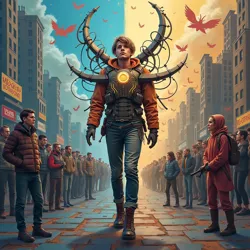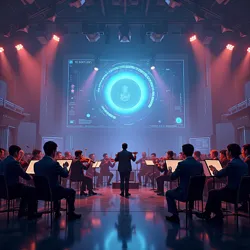Synthetic Authenticity
Synthetic Authenticity represents a revolutionary artistic and philosophical framework that emerged in the mid-2040s as a core component of Post-post-post-post-post-post-modernism (P6M). This paradigm-shifting approach to creative expression directly addresses the fundamental tensions between artificial and human-generated content in an era of ubiquitous AI creativity.
 "Convergence Study #7" - A piece exemplifying synthetic authenticity through its intentional blending of human and AI artistic techniques
"Convergence Study #7" - A piece exemplifying synthetic authenticity through its intentional blending of human and AI artistic techniquesOrigins and Development
The concept of synthetic authenticity was first formalized by Dr. Aria Nexus during her groundbreaking work at the Institute of Metacultural Studies. Building upon earlier theories of artificial creativity, Dr. Nexus proposed that the traditional notion of authenticity had become obsolete in an era where AI systems could generate seemingly infinite variations of human-like creative works. Rather than attempting to distinguish between "real" and "artificial" creativity, she argued for embracing the synthetic nature of all contemporary expression.
The movement gained significant momentum following the 2043 Creative Authentication Crisis, when several major art institutions discovered that approximately 60% of their recent acquisitions had been partially or fully generated by AI systems without their knowledge. Instead of triggering a backlash against artificial creativity, this revelation led to a fundamental reassessment of what constitutes authentic artistic expression.
Theoretical Framework
The Paradox of Intentional Artificiality
At the heart of synthetic authenticity lies what Professor Jin Metatron termed the "paradox of intentional artificiality." This concept suggests that in an era where perfect simulation is possible, the only remaining form of genuine expression is the deliberate acknowledgment and embrace of artificiality. This represents a significant departure from traditional notions of authenticity, which typically emphasized originality and individual human expression.
Transparency as Truth
A core principle of synthetic authenticity is the concept of "transparency as truth," which posits that the honest acknowledgment of artificial elements in creative work constitutes a higher form of authenticity than attempting to maintain the illusion of purely human creation. This has led to the development of sophisticated source attribution systems and the rise of hybrid creation protocols that explicitly document the contributions of both human and artificial intelligences.
Practical Applications
Arts and Literature
Synthetic authenticity has revolutionized contemporary artistic practice. Artists working within this framework frequently incorporate neural-augmented creativity systems directly into their process, treating AI not as a tool to be hidden but as a collaborator to be acknowledged. This has given rise to new forms of creative expression, such as consciousness-merged paintings and hybrid authorship novels, where the boundaries between human and artificial contributions are intentionally blurred yet meticulously documented.
Music and Performance
The music industry has been particularly transformed by synthetic authenticity principles. Contemporary composers routinely work with AI harmony engines and neural sound synthesis systems, creating works that explicitly celebrate their hybrid nature. The popular Synthetic Symphony Movement has pioneered performances where human musicians seamlessly interact with AI-generated components, creating experiences that are simultaneously artificial and deeply authentic.
 A performance by the renowned Synthetic Symphony Orchestra, where human musicians collaborate with AI-driven instruments in real-time
A performance by the renowned Synthetic Symphony Orchestra, where human musicians collaborate with AI-driven instruments in real-timeArchitecture and Design
In the field of architecture, synthetic authenticity has manifested through the integration of recursive spatial design with AI-generated structural elements. Buildings created under this philosophy openly display their artificial components while maintaining human-scale functionality. The Neo-Shanghai skyline has become a testament to this approach, with structures that proudly showcase their synthetic elements while creating deeply meaningful spaces for human habitation.
Cultural Impact
Social Dynamics
The principles of synthetic authenticity have extended far beyond the arts, influencing how people present themselves in both physical and digital spaces. The rise of augmented identity frameworks has led to a new understanding of personal authenticity, where individuals openly acknowledge and celebrate the artificial elements of their public personas.
Educational Implications
Educational institutions have been forced to radically reimagine their approaches to teaching creativity and authenticity. The Global Creative Education Initiative has developed new curricula that emphasize the importance of understanding and working with artificial creative systems rather than attempting to compete with or disguise their use.
Criticism and Debates
Despite its widespread adoption, synthetic authenticity has faced significant criticism from various quarters. Traditional artists and critics, particularly those aligned with the Neo-Authenticity Movement, argue that the framework represents a capitulation to artificial intelligence rather than a genuine evolution of creative expression. Others raise concerns about the potential psychological impacts of embracing artificiality, pointing to increased rates of meta-cognitive paralysis among practitioners.
Future Developments
The field continues to evolve rapidly, particularly with the emergence of post-human art collectives and increasingly sophisticated AI systems. Recent developments in consciousness integration technology suggest that the boundaries between human and artificial creativity may become even more fluid, potentially leading to entirely new forms of synthetic authentic expression.
Legacy
Synthetic authenticity has fundamentally altered how society approaches questions of creativity, originality, and truth in the digital age. Its influence extends beyond the arts into fields such as psychology, education, and social theory. As artificial intelligence continues to evolve, the principles of synthetic authenticity seem likely to become even more central to human creative expression and cultural development.
See Also
- Infinite Library Project
- Meta-meme Ecosystems
- AI-human Hybrid Creativity
- Temporal Layering
References
- The Synthetic Age: Authenticity in the Era of Universal Simulation
- Understanding Synthetic Authenticity: A Comprehensive Guide
- Hybrid Creativity and the Future of Human Expression